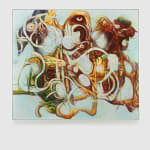-
Artworks








Discriminator, 2022
Oil and ink on canvas66 x 76 x 1 1/4 in.
167.6 x 193 x 3.2 cm$ 150,000.00Further images
-
(View a larger image of thumbnail 1
)

-
(View a larger image of thumbnail 2
)

-
(View a larger image of thumbnail 3
)

-
(View a larger image of thumbnail 4
)

-
(View a larger image of thumbnail 5
)

-
(View a larger image of thumbnail 6
)

-
(View a larger image of thumbnail 7
)

-
(View a larger image of thumbnail 8
)

The 'Branches' series follows Ritchie’s current practice of training artificial intelligence programs called generative adversarial networks (GANs) to produce unrecognizable yet strangely familiar configurations from which paintings are intuitively developed....The "Branches" series follows Ritchie’s current practice of training artificial intelligence programs called generative adversarial networks (GANs) to produce unrecognizable yet strangely familiar configurations from which paintings are intuitively developed. Although they were originally based on computer programs, the paintings evoke sources drawn from nature. They echo the root monsters found in multiple folk traditions, including the Green Man of Ritchie’s Celtic ancestors and the work of East Tennessee folk artist Bessie Harvey, as well as the vegetable-face assemblages of Giuseppe Arcimboldo and frottage rubbings of Max Ernst. They are born of the same tendency to see something human in an inhuman source and then emphasize the anthropomorphic features through art–a kind of call-and-response process.
In "Discriminator", Ritchie imagines the GAN is actually making a picture of itself as two invisible beings that interact with one another: the generator, shown as a dense tangle of possible interpretations, and the discriminator, a slightly less intricate form dominated by an all-seeing eye at the top. No longer merely producers of unpredictable images, GANs are personified here as anatomical structures. They are technology become flesh. Ritchie pushes this transubstantiation further in Infinite Movement, his 2021 opera co-created with Shara Nova, which casts the discriminator and the generator of the GANs as dueling divine characters.
Exhibitions
Matthew Ritchie, "A Garden in the Flood", Frist Art Museum, Nashville, TN, Nov 11, 2022–Mar 5, 2023.1of 2 -
(View a larger image of thumbnail 1
)







